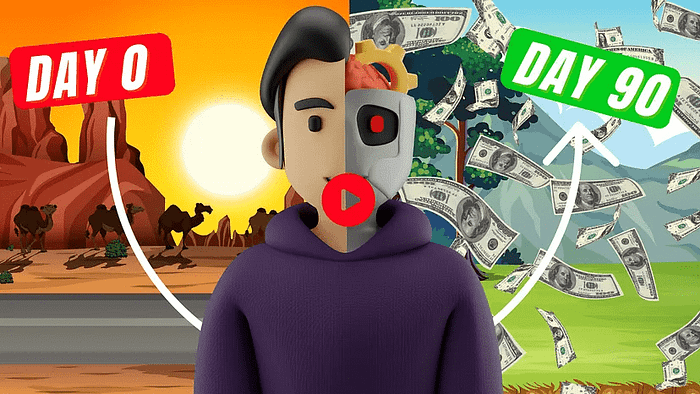How AI Generated $600K Revenue for My Construction Business in Just 6 Months
The revolutionary impact of artificial intelligence on local businesses has become increasingly evident, particularly in traditional industries like construction. After moving to Calgary, Canada, from the UK, I discovered an unexpected opportunity to transform the construction industry using AI-powered marketing strategies. This journey not only led to generating $600,000 in revenue within six months but also revealed a scalable blueprint for other local service businesses. The integration of AI tools with traditional construction marketing opened up new possibilities that traditional advertising methods simply couldn’t match. The transformation from skepticism to success proved that even the most conventional industries could benefit from artificial intelligence innovations.
We strongly recommend that you check out our guide on how to take advantage of AI in today’s passive income economy.
Table of Contents
The Genesis: From E-commerce to Construction
My background in e-commerce and digital marketing seemed worlds apart from the construction industry. However, a personal experience with my sister-in-law’s basement renovation project, which dragged on for seven months instead of the promised six weeks, sparked an idea. The construction industry, particularly in Canada where the government had announced plans to build four million homes, presented an untapped opportunity for someone with digital marketing expertise. The frustration of dealing with traditional construction timelines and communication methods revealed a significant gap in the market. This realization led me to leverage my experience in digital marketing and scale it into an entirely new industry.
The transition wasn’t without its challenges. Coming from an e-commerce background where everything moves at lightning speed, adapting to the construction industry’s pace required significant adjustment. However, this contrast became an advantage. The digital marketing strategies that had proven successful in e-commerce could be modified and applied to construction, creating a unique blend of traditional service and modern marketing approaches. The key was understanding both worlds and finding the sweet spot where they could complement each other.
Identifying the Market Gap
The construction boom in Canada created a unique niche. While builders focused on constructing new homes, they weren’t finishing basements – a crucial element for homeowners looking to maximize their property’s potential. This gap in the market, combined with my expertise in digital marketing and client acquisition, formed the foundation of my business strategy. The opportunity became even more apparent when analyzing the local market data. New homeowners were increasingly looking to customize their spaces, particularly basements, to create additional living areas or rental units.
Market research revealed that traditional construction companies were struggling with lead generation and client communication. Many relied on word-of-mouth marketing or expensive traditional advertising methods that yielded inconsistent results. The lack of transparency in pricing and processes created friction in the customer journey, leading to hesitation and distrust. This insight became crucial in developing our unique value proposition.
The AI-Powered Content Strategy
The traditional approach to construction marketing typically involves expensive paid advertising campaigns that often yield low-quality leads. Instead, I developed what I call the “Authority Protocol” – a content strategy powered by artificial intelligence that establishes credibility before the first client interaction. This approach fundamentally changed how potential clients perceived and interacted with our construction business.
The Authority Protocol works on multiple levels. First, it positions the business as an educational resource rather than just a service provider. By sharing insider knowledge about construction processes, costs, and timelines, we built trust with potential clients before they even reached out. This transparency, combined with AI-generated content’s consistency and quality, created a powerful marketing engine that practically ran itself.
Research and Content Categories
The first step involved comprehensive research into viral construction content. By analyzing successful content in the construction niche, I identified four distinct categories that consistently performed well. This included cost breakdowns of construction projects and behind-the-scenes footage of actual work being done. The research phase revealed that audiences were particularly interested in content that demystified the construction process.
Each content category served a specific purpose in our marketing funnel. Cost breakdown videos addressed the primary concern of potential clients – pricing transparency. Behind-the-scenes content built trust by showing our actual work processes. Time-lapse videos of project completions demonstrated our efficiency and quality. Educational content about materials and techniques positioned us as industry experts.
The key to success was understanding the psychological triggers that made content shareable. People weren’t just interested in construction – they were interested in the transformation stories, the cost-saving tips, and the insider knowledge that could help them make better decisions about their own projects.
Leveraging AI Tools
My content creation process utilized two primary AI tools: ChatGPT for script writing and Eleven Labs for voice generation. This combination allowed for rapid content production while maintaining high quality and engagement. The AI-generated scripts maintained a fast-paced, engaging tone that kept viewers watching until the end. The integration of these tools streamlined our content production process, reducing what would typically take days into a matter of hours.
The AI tools weren’t just about efficiency – they brought consistency and professionalism to our content that would have been difficult to maintain otherwise. ChatGPT helped create scripts that were informative yet conversational, while Eleven Labs provided professional-quality voiceovers that added credibility to our content. The key was finding the right balance between automation and human touch, ensuring that our content remained authentic despite being AI-assisted.
The Results: Viral Success and Lead Generation
The impact of this AI-powered strategy was remarkable. One content piece achieved 6.6 million views, while several others consistently reached the million-view mark. This organic reach translated into tangible business results – generating 835 qualified leads over four months. The viral success wasn’t just about numbers – it was about reaching the right audience with the right message at the right time.
What made our content truly effective was its ability to pre-qualify leads. By being transparent about our pricing and processes in our content, we attracted clients who were already aligned with our value proposition. This significantly reduced time spent on unqualified leads and improved our conversion rates. The organic reach also meant we were building a sustainable marketing channel that didn’t rely on continuous ad spend.
The Authority Advantage
The viral content strategy created what I call “perceived authority.” When potential clients reached out, they were already pre-sold on our value proposition. This allowed us to command premium prices without being viewed as just another commodity in the market. The authority we built through content marketing translated into higher conversion rates and better client relationships.
This perceived authority had a compound effect. Each successful project led to more content opportunities, which in turn led to more authority in the market. Clients who came through our content marketing funnel were more likely to trust our expertise and accept our recommendations, leading to smoother project executions and better outcomes for everyone involved.
Transparency as a Competitive Edge
One key differentiator in our content strategy was complete transparency about pricing. While most contractors prefer to keep their pricing structure opaque, we created detailed breakdowns of each construction phase and associated costs. This transparency resonated strongly with our audience and significantly contributed to our lead conversion rate. By demystifying the pricing structure, we eliminated one of the biggest barriers to client trust in the construction industry.
Our transparency extended beyond just pricing. We shared our processes, timelines, and potential challenges openly in our content. This approach not only built trust but also educated clients about what to expect, leading to smoother project executions and higher client satisfaction. The transparency created a virtuous cycle – informed clients made better decisions, leading to better project outcomes, which in turn provided more positive content for our marketing.
The Financial Impact
The results speak for themselves: From a single viral video breaking down basement development costs, we generated approximately 500 leads in the first month alone. This momentum continued, leading to $600,000 worth of booked projects within just four months. But the financial impact went beyond just revenue numbers. The quality of leads improved dramatically, reducing our customer acquisition costs and increasing our profit margins.
The financial success wasn’t just about the immediate revenue – it was about building a sustainable business model. The content we created continued to generate leads long after it was published, creating a compound effect that traditional advertising couldn’t match. This long-tail effect of content marketing, powered by AI, created a predictable and scalable lead generation system.
Scaling Challenges and Solutions
Success brought its own challenges, particularly in terms of operational capacity. The influx of projects required careful management to ensure quality delivery. This led to strategic decisions about growth pace and project selection. We had to develop systems and processes to handle the increased volume while maintaining our high standards of quality and customer service.
The scaling process taught us valuable lessons about business growth. We learned to balance our marketing efforts with our operational capacity, ensuring we could deliver on the promises made in our content. This meant sometimes slowing down our content production to match our ability to take on new projects, maintaining the quality that had built our reputation.
The Future: AI-Driven Local Service Marketing
This success story isn’t limited to construction. The same AI-powered marketing strategy can be applied to any local service business. The key elements – transparent pricing, authority building through content, and AI-assisted content creation – form a replicable blueprint for success. The future of local service marketing lies in combining traditional expertise with modern AI tools.
The potential for AI in local service businesses is just beginning to be realized. As AI tools become more sophisticated, the opportunities for automation and optimization will only increase. The key will be maintaining the human element while leveraging AI’s capabilities to enhance efficiency and reach.
Conclusion
The integration of AI in traditional business marketing represents more than just a technological advancement – it’s a paradigm shift in how local service businesses can acquire customers and build authority. By leveraging AI tools for content creation and marketing, businesses can achieve significant growth without relying on expensive paid advertising.
The success of this approach in the construction industry demonstrates that AI isn’t just for tech companies. Traditional businesses can harness its power to transform their marketing strategies and achieve remarkable results. The key lies in understanding your market, creating valuable content, and using AI tools strategically to scale your reach and impact.
The journey from a traditional construction business to an AI-powered success story shows that innovation isn’t about replacing human expertise – it’s about enhancing it. By embracing AI tools while maintaining focus on delivering real value to customers, any local service business can achieve similar transformative results.

We strongly recommend that you check out our guide on how to take advantage of AI in today’s passive income economy.




